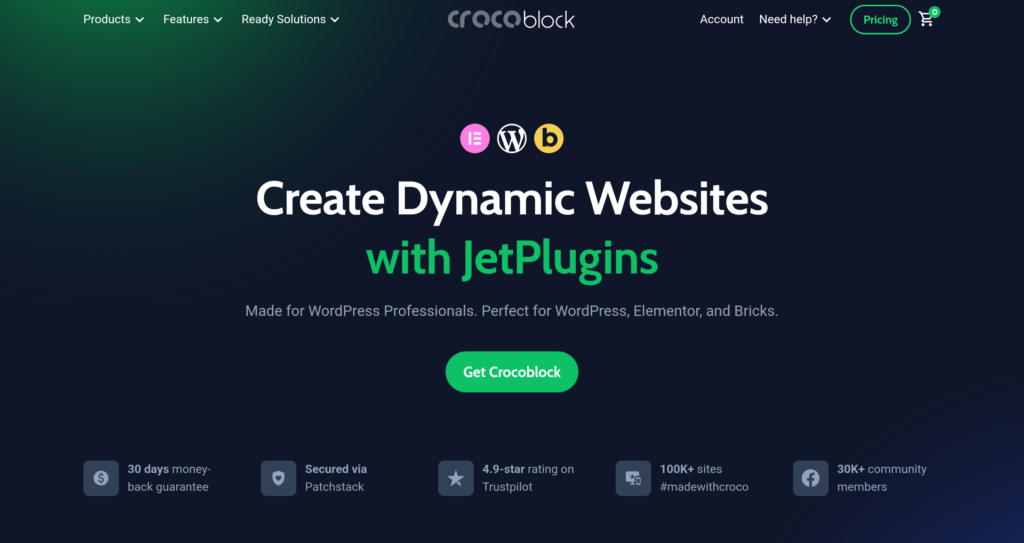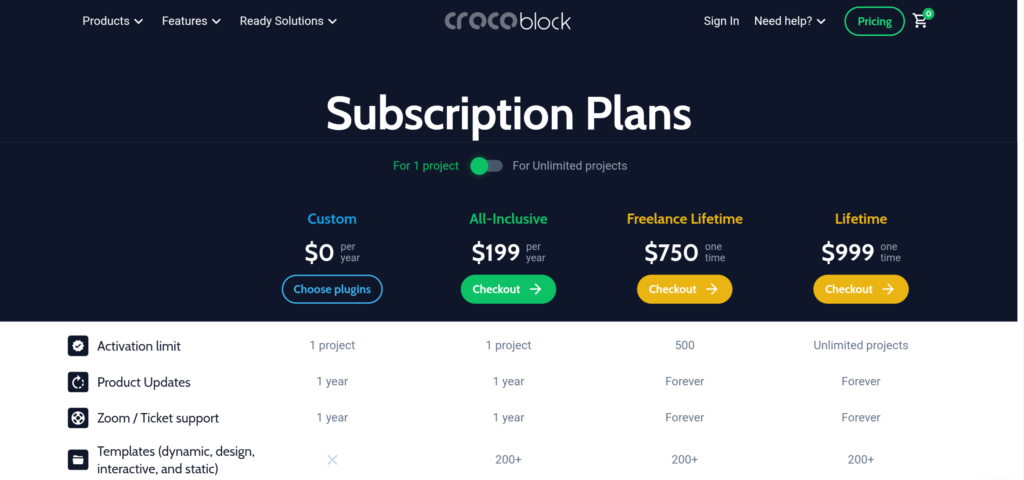If you’ve been building WordPress sites for a while, chances are you’ve stumbled across the colorful, oddly satisfying world of Crocoblock. Or maybe you Googled something like “Elementor dynamic content” and landed on a JetEngine tutorial. Either way, you’re not alone. Crocoblock has carved out a serious space in the world of no-code website creation.
But is it still worth using in 2025?
Here’s my honest Crocoblock review, from one WordPress tinkerer to another. Spoiler: it’s not all sunshine and popups.
First, What Is Crocoblock?

Crocoblock is a toolkit of WordPress plugins, known as JetPlugins, that help you build feature-rich, dynamic websites without coding. Initially made for Elementor Review, Crocoblocks now works with Gutenberg and Bricks Builder, too.
In total, you get 20+ plugins, over 200 widgets, templates for different niches, and a centralized dashboard that keeps your WordPress backend looking somewhat sane (at least until your plugin count hits 50+).
And despite what autocorrect might tell you, it’s not “crockoblock” or “crocobloc.” It’s Crocoblock. With a K. Think Lego bricks for web devs.
JetPlugins Breakdown: The Real Reason You’re Here
Here’s what you’re really paying for: the JetPlugins suite.
Let’s talk JetEngine, because this plugin alone could justify your Crocoblock subscription. It lets you create custom post types, custom fields, relationships between post types, front-end forms, dynamic listings, maps, filters, you name it. If you’ve used ACF before but wished it was built for visual thinkers, JetEngine is for you.
You can use JetEngine with:
- Elementor
- Gutenberg
- Bricks Builder
The plugin is also the foundation for others in the Crocoblock family, including JetBooking and JetAppointment. So if you’re running any kind of dynamic directory, real estate listing, event platform, or anything with user-submitted content, JetEngine turns your WordPress site into a custom database without touching SQL.
That said, the learning curve is real. There are a lot of moving parts. Don’t expect to master JetEngine over coffee.
Other standout JetPlugins include:
- JetSmartFilters: Advanced filtering for any kind of post type or WooCommerce product.
- JetFormBuilder: A surprisingly powerful form builder with conditional logic and integrations.
- JetWooBuilder: Lets you customize WooCommerce product pages like a boss.
- JetPopup: Yep, it does popups, exit intent, time delay, scroll, and all.
- JetMenu: For mega menus that don’t make you mega frustrated.
You can buy each plugin individually, but most people (myself included) go for the All-Inclusive plan. More on that later.
Elementor, Gutenberg, Bricks: It’s Not a One-Theme Pony Anymore
Crocoblock used to be Elementor-only, and that’s how most people discovered it. But in the past couple of years, they’ve opened up support for Gutenberg and Bricks. JetEngine, JetSmartFilters, and JetFormBuilder now support all three.
This is great news if you’re trying to future-proof your stack. With WordPress pushing hard on full site editing, having Gutenberg compatibility is not just nice; it’s necessary.
What’s It Like to Use Crocoblock in Real Projects?
Once installed, Crocoblock gives you a unified dashboard inside WordPress where you can manage all your JetPlugins. Install, update, deactivate, or even roll back to earlier versions if something breaks. (That feature alone has saved me during a few plugin clashes.)
The real strength of Crocoblocks is how the plugins work together. For example, you can:
- Build a listing grid with JetEngine
- Add front-end filters with JetSmartFilters
- Style the whole thing in Elementor
- Drop in a dynamic form built with JetFormBuilder
No custom code. No third-party workarounds. Just you, your mouse, and a slightly overworked CPU.
Dynamic Templates and Widgets Galore
Crocoblock includes dynamic templates for various industries like real estate, job boards, doctor appointments, and so on. These are pre-built setups that include CPTs, filters, and layouts. If you’re building client sites or MVPs, they can save you hours and maybe even days.
You’ll also get 200+ Elementor widgets through plugins like JetElements and JetTricks. Some are genuinely useful (like tables and pricing sliders), others are more novelty (Lottie animations everywhere), but the selection is wide.
A small gripe: some widgets feel like they belong in the same plugin. JetElements, JetTabs, and JetBlog, for example, could probably be bundled. There’s plugin fatigue when you’re installing 15+ things just to get basic UI elements.
What Could Be Better?
Alright, let’s talk trade-offs.
Crocoblock’s biggest strength, its modularity, is also its weakness. Managing 20 plugins, especially on big projects, can feel overwhelming. And while the dashboard helps, your Plugins screen in WordPress still gets cluttered fast.
Also, not every plugin supports every builder. JetWooBuilder only works with Elementor. So if you’re team Gutenberg or Bricks, you’ll run into the occasional dead end.
And let’s be honest: Elementor itself has gotten better. A lot of Crocoblock’s early appeal was that it added features Elementor was missing. But now, Elementor Pro includes things like loop builders and display conditions, which makes some JetPlugins feel redundant.
Still, there are areas where Crocoblock clearly wins:
- Better dynamic content workflows
- More powerful front-end filters
- Visual control over CPTs and meta fields
- AI-assisted tools (yes, they’re rolling that in now, too)
Pricing: Is the All-Inclusive Plan Worth It?

If you’re doing client work, yes. No question.
The All-Inclusive plan is $199/year and includes every JetPlugin, dynamic templates, widgets, and support. If you go the freelance route, you can pay $750 for lifetime access, which includes updates and support.
Honestly, one decent client project pays for that. Even better if you stack it with a Crocoblock discount coupon.
For hobbyists or one-off projects, the value is more debatable. If all you want is dynamic listings and basic filters, JetEngine alone might be enough.
Fastest Hosting for Crocoblock
There’s no point building a lightning-fast site with JetEngine if your hosting crawls like it’s stuck in 2006. Crocoblock sites, especially those using dynamic content, filters, and WooCommerce, can be resource-hungry.
That’s where Rapyd Cloud comes in. Our infrastructure is built to handle dynamic WordPress sites at scale. Whether you’re pulling content from complex custom post types or running filtered queries with JetSmartFilters, Rapyd Cloud keeps your site zipping along without the headache of slow load times.
- Real-time performance monitoring
- Autoscaling to handle traffic spikes
- Built-in caching optimized for Crocoblock workflows
- Developer-friendly tools with zero bloat
If you want to get the most out of your Crocoblock setup, fast hosting isn’t optional; it’s essential. Pair your Jet-powered stack with Rapyd Cloud and give your users the speed they expect.
The Verdict: Is Crocoblock Still Recommended in 2025?
Yes, especially if you build complex or client-heavy sites in WordPress.
Despite Elementor catching up and the increasing capabilities of Gutenberg, Crocoblock still offers more control over dynamic content than most plugins on the market. The JetEngine plugin alone is worth a look if you’re serious about building advanced functionality without a developer.
The ecosystem isn’t perfect, and there’s a bit of plugin overload. But the payoff is huge once you get the hang of it.
TL;DR:
- Crocoblock is still a powerhouse for dynamic WordPress sites
- JetEngine is the real MVP
- All-Inclusive plan = best value
- Don’t type “crockoblock” or “crocobloc”, your search results will cry
If you’re in the trenches building sites that need more than just pretty pages, Crocoblocks are still one of the best no-code tools to have in your toolbox.
And hey, while you’re optimizing your front-end experience with JetEngine, let Rapyd Cloud handle the speed, reliability, and infrastructure on the back end. Because even the most dynamic site won’t matter if it loads slower than your coffee pot.
Happy building.





